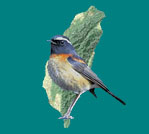 |
|
||||||||||||
|
|
|||||||||||||
 |
|
||||||||||||
|
|
|||||||||||||
|
Endemic Species White-whiskered Laughingthrush
Yellow Tit
Endemic Sub-Species
Crested Serpent-Eagle
Streak-breasted Scimitar-Babbler
More Birds in Taiwan |
Ring-necked Pheasant Phasianus colchicus formosanus Endemic Subspecies
The male Ring-necked Pheasant is a large (80 cm), colourful bird with a bright red wattle of bare skin surrounding the eye and hanging over the face, short ear tufts, a glossy black neck with a greenish sheen bordered at the base on the dorsal side by a white collar, and a long pointed olive green tail barred with black, approximately equal to the length of its body. Its breast and sides are covered with colourful feathers containing dark green, copper and gold markings and the wing bears a silvery gray patch. The rump is greenish with black spots. A major characteristic of the formosanus subspecies is a large creamy-white panel spotted with black, on the side of the breast in front of the wing. Also, in most other races the tail is brown rather than olive green. The female also has a long pointed tail, but is generally dark brown with buffy feather edges above, and lighter brown with a faint scaly pattern below. Ring-necked Pheasants eat a varied diet of seeds, leaves, fruit, buds, and insects. They will visit cultivated fields to feed on grains. Their habitat includes brushy fields and open areas, hilly areas close to cultivation, open woods and farmland. Ring-necked Pheasants nest on the ground, where females lay 9-14 eggs in a shallow depression lined with plant material. In the breeding season, males produce a hoarse, explosive two-part call, with the second part lower-pitched. At this time males may fight each other for territorial dominance. In Taiwan the Ring-necked Pheasant is known as the "Pearl of the Grasslands". Although it is now protected by law, the population of Ring-necked Pheasants has seriously declined. They can be found in eastern Taiwan, in Taitung and Hualien, and in the sugar-cane area of Tainan in western Taiwan. Particularly in western Taiwan, conversion of large areas of sugar-cane to industrial and residential areas has resulted in destruction of much of the pheasants' habitat. Furthermore, interbreeding of the Taiwanese subspecies with imported foreign subspecies has also contributed to its decline.
References: Handbook of Birds of the World Vol. 2; A Field Guide to the Birds of China (Mackinnon and Phillipps); Taipei Times, Aug. 11, 2001, "Afforestation helps `pearl of grasslands' " By Levina Sung
|